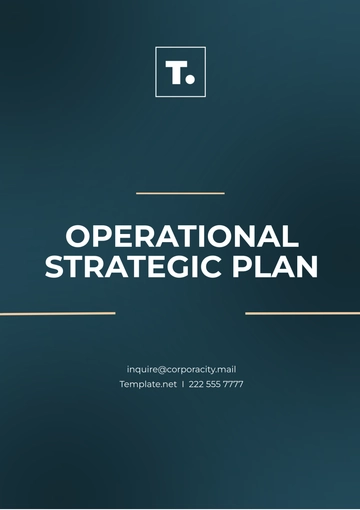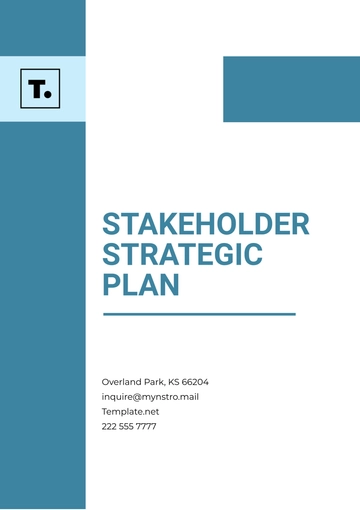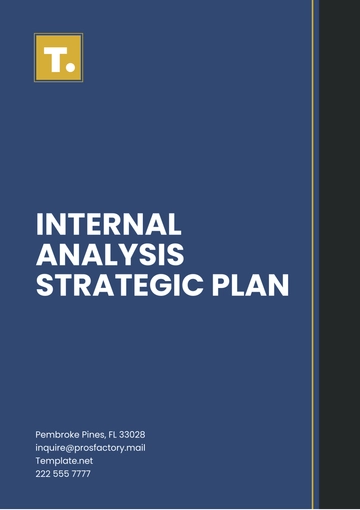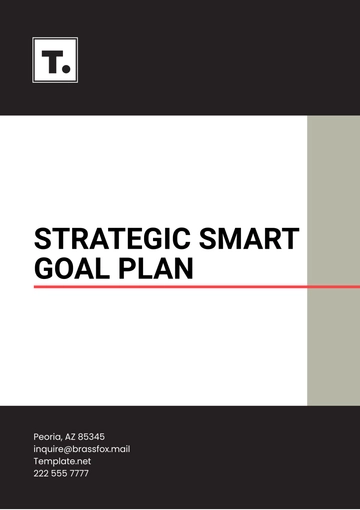Free Board of Director Strategic Plan

1. Introduction
This strategic plan outlines the core objectives and initiatives that [Your Company Name] will focus on over the coming years, from 2050 onward. It is designed to guide the company’s Board of Directors and senior leadership in making informed decisions that align with the company’s mission, vision, and long-term goals. The plan is structured to address key areas of governance, operational performance, financial growth, market expansion, sustainability, and social responsibility. This document serves as a comprehensive guide to steer [Your Company Name] through a rapidly changing business environment, ensuring the company's continued success for decades to come.
1.1 Purpose of the Strategic Plan
The primary purpose of this strategic plan is to provide a roadmap for [Your Company Name]'s growth and development over the next decades. The plan outlines key goals for the organization and identifies specific strategies that will enable [Your Company Name] to meet the evolving challenges and opportunities within its industry. By aligning the Board of Directors with a unified vision, this strategic plan aims to ensure the organization’s continued success, innovation, and financial stability. The plan also serves as a reference for decision-making and helps ensure that every level of the organization is working toward the same long-term objectives.
1.2 Scope and Timeframe
This strategic plan covers a period extending through 2050 and beyond, and focuses on a long-term horizon to ensure that [Your Company Name] adapts to market trends, technological advancements, economic shifts, and changing customer preferences. Key strategic objectives and initiatives will be revisited and adjusted periodically to reflect real-time data and performance metrics, ensuring flexibility in response to unforeseen changes in the business environment. Regular annual reviews will take place to ensure the plan remains relevant, and quarterly assessments will allow for faster responses to market and operational challenges.
2. Strategic Vision and Mission
2.1 Vision Statement
The vision of [Your Company Name] is to become a global leader in [industry] by driving innovation, delivering exceptional value to our customers, and fostering a culture of sustainability and ethical leadership. Our focus on technological advancement, customer satisfaction, and operational excellence will set the foundation for future success. By 2050, [Your Company Name] aims to establish itself as the leading provider of tech services globally, recognized not only for quality and innovation but also for our positive impact on society and the environment. Our vision is also centered on fostering a diverse and inclusive workplace where creativity thrives, and everyone has the opportunity to contribute to the company’s growth.
2.2 Mission Statement
[Your Company Name] is dedicated to delivering high-quality products and services that meet the needs of our diverse customer base. Our mission is to foster long-term relationships with clients, ensure employee development, and maintain a commitment to environmental stewardship. We will leverage cutting-edge technologies and data-driven decision-making to enhance performance and achieve measurable results in all areas of our operations. At the heart of our mission is the desire to continuously enhance the customer experience, create lasting partnerships, and ensure that the company operates responsibly and transparently.
3. Core Values
The core values of [Your Company Name] define the way we conduct business, interact with stakeholders, and create value for our customers. These values underpin our culture, strategic initiatives, and daily operations, and will guide us in the pursuit of our goals.
3.1 Innovation
We prioritize creativity and forward-thinking solutions in all aspects of our business. Our commitment to innovation enables us to stay ahead of industry trends and adapt to changing market demands. By 2050, we aim to have a portfolio of cutting-edge products and services that reflect the latest technological advancements and trends, from AI-powered solutions to sustainable and eco-friendly innovations.
3.2 Integrity
We uphold the highest standards of ethical conduct, transparency, and accountability. Integrity is essential to earning and maintaining the trust of our customers, employees, and shareholders. Every decision made by [Your Company Name] will be driven by ethical considerations, and we will establish policies to ensure accountability at every level. This includes an open-door policy where employees and customers can voice concerns, ensuring the company remains transparent and trustworthy.
3.3 Sustainability
We are dedicated to reducing our environmental impact and adopting sustainable business practices that benefit both society and future generations. Sustainability is central to our long-term strategy and operations. We will focus on reducing carbon emissions, minimizing waste, and using renewable resources, all while helping our customers do the same. Our sustainability goals include reducing our carbon footprint by [25]% by 2055 and achieving a net-zero emission status by 2070.
3.4 Customer-Centricity
Our customers are at the heart of everything we do. We are committed to delivering exceptional service and value, ensuring that their needs are met with excellence and efficiency. [Your Company Name] will implement a robust customer feedback system to ensure that we are meeting customer expectations and continuously improving our products and services. By 2050, we aim to achieve a customer satisfaction rate of [90]%, with a goal of becoming a trusted partner for our clients and customers globally.
3.5 Employee Empowerment
We believe in empowering our employees by providing them with opportunities for growth, training, and development. A motivated and well-trained workforce is essential to achieving our goals. [Your Company Name] will continue to invest in employee development through comprehensive training programs and leadership development opportunities. By 2050, we aim to increase employee retention by [15]% and foster an organizational culture that encourages innovation, collaboration, and leadership at all levels.
4. Market Analysis
4.1 Industry Overview
The global [industry] market is projected to experience significant growth over the next few decades. Technological advancements, shifting consumer preferences, and sustainability concerns are driving changes across the sector. By 2050, the industry is expected to be worth $[1 trillion], with a [6]% annual growth rate. [Your Company Name] aims to capitalize on these trends by innovating and expanding into new markets. The company is also committed to integrating the latest advancements in digital transformation, including AI and blockchain, to enhance operational efficiency and product offerings.
4.2 Competitive Landscape
The competitive landscape in the [industry] is evolving, with both established players and new entrants vying for market share. [Your Company Name] faces competition from global giants, as well as smaller, more agile competitors who are disrupting traditional business models. To maintain a competitive edge, [Your Company Name] will focus on differentiation through innovation, superior customer service, and sustainable practices. This includes continuous investment in R&D, the use of data analytics to anticipate market trends, and forming strategic alliances that enhance our market positioning.
4.3 SWOT Analysis
A comprehensive SWOT analysis has been conducted to evaluate [Your Company Name]'s strengths, weaknesses, opportunities, and threats in the current market environment.
Strengths | Weaknesses |
|---|---|
Strong brand recognition ($500 million annually) | Limited global presence in some markets |
Established customer base (over 10 million active customers) | High dependence on specific suppliers |
Robust research and development (R&D) investment ($50 million annually) | Need for digital transformation in some areas |
Dedicated and skilled workforce | Infrastructure limitations in some regions |
Opportunities | Threats |
|---|---|
Expansion into emerging markets ($200 million in new markets) | Economic volatility and global recessions |
Leveraging AI and automation technologies ($100 million investment) | Regulatory changes and compliance risks |
Growing demand for sustainable products ($500 million annually) | Intense competition and price pressures |
Strategic partnerships and acquisitions ($300 million target) | Supply chain disruptions |
4.4 Key Market Trends
The following market trends will shape [Your Company Name]'s strategy in the coming decades:
Technological Innovation: Rapid advancements in AI, machine learning, and automation will offer new opportunities for product development and operational efficiencies. This includes automated manufacturing and personalized customer experiences driven by AI algorithms.
Sustainability Focus: As consumers become more environmentally conscious, there is an increasing demand for sustainable products and services. By 2050, consumers will prioritize eco-friendly products, and regulatory frameworks will push for greater sustainability across industries.
Globalization: Expansion into emerging markets will become increasingly important, offering new growth opportunities for [Your Company Name]. Key markets for expansion include Asia-Pacific, Africa, and Latin America, where rising middle-class populations are creating demand for premium goods and services.
Digital Transformation: The need for digital tools, cloud computing, and data analytics will continue to grow, shaping how businesses interact with customers and manage operations. [Your Company Name] will invest in digital platforms to improve customer engagement, optimize operations, and unlock new revenue streams.
5. Strategic Objectives
The strategic objectives of [Your Company Name] focus on driving the company toward long-term success, growth, and sustainability. By 2050 and beyond, the company aims to solidify its position as a leader in the industry while aligning with its vision and core values. These objectives serve as the foundation for the company's overall strategy and provide clear direction for growth across financial, market, innovation, and customer satisfaction areas.
5.1 Financial Growth
Financial growth is essential for ensuring the company's continued expansion and ability to invest in new opportunities. [Your Company Name] has set ambitious revenue and profitability targets for the coming decades, aiming for consistent year-on-year growth. The following financial growth objectives are key to achieving the desired success:
Achieve sustained revenue growth of [8]% annually: Over the next decades, [Your Company Name] aims to increase its annual revenue growth by [8]% on average. This will be achieved through strategic market expansion, development of new products, and enhanced operational efficiencies.
Reach total revenue of $[15 billion] by 2055: With a focus on scaling operations and expanding into emerging markets, [Your Company Name] will aim for a significant increase in revenue, reaching $[15 billion] by 2055.
Increase profitability by improving operational efficiencies: The company plans to reduce costs by [10]% within the next [5] years through process improvements, automation, and optimized supply chain management. This will allow the company to maintain competitive pricing while enhancing profitability.
Diversify revenue streams: To mitigate the risks associated with reliance on a few product lines, [Your Company Name] will diversify its portfolio, introducing new services or solutions that align with market demand. This diversification is expected to account for an additional [15]% of total revenue by 2055.
Maintain healthy margins: Focused efforts will be made to sustain gross margins of at least [40]%, which will be supported by strategic pricing strategies, cost-saving measures, and high-value product offerings.
5.2 Market Expansion
To drive long-term growth, [Your Company Name] will pursue aggressive market expansion strategies, targeting high-growth regions and emerging markets. The goal is to extend the company’s reach while adapting offerings to local market needs. Key market expansion objectives include:
Expand into emerging markets: By 2055, [Your Company Name] will aim to generate [20]% of its total revenue from markets outside of its core operating regions. This will be achieved by entering emerging markets in Asia-Pacific, Africa, and Latin America, which are forecasted to experience significant economic growth and increasing demand for premium products.
Form joint ventures and partnerships: Expanding into new markets will require local expertise and operational flexibility. [Your Company Name] will explore joint ventures and strategic partnerships with established local firms to ease entry into these markets. These partnerships will also help in understanding regulatory requirements, consumer preferences, and supply chains.
Develop region-specific products and services: Tailoring products to meet local tastes, cultural preferences, and market demands will be critical. By adapting existing products or developing new solutions suited to regional needs, [Your Company Name] will gain a competitive advantage in new markets. This customization is projected to contribute an additional [15]% of overall revenue.
Establish a global presence: [Your Company Name] will aim to increase its market share in key regions by building a robust physical presence through regional offices, distribution centers, and manufacturing plants. This will also help to reduce lead times and optimize logistics, enabling the company to provide faster services to customers in these regions.
5.3 Innovation and R&D
Innovation is a cornerstone of [Your Company Name]’s long-term strategy. Continuous investment in research and development (R&D) will be vital in maintaining a competitive edge and introducing breakthrough products and services that address emerging customer needs. Strategic R&D objectives include:
Allocate [5]% of annual revenue to R&D: [Your Company Name] will allocate a minimum of [5]% of its annual revenue, which amounts to $[750 million] in the early years, toward R&D efforts. This investment will fund the development of new technologies, product lines, and customer solutions.
Focus on cutting-edge technologies: [Your Company Name] will direct its R&D efforts toward emerging technologies such as artificial intelligence (AI), machine learning, blockchain, and the Internet of Things (IoT). By integrating these technologies into products and operations, the company will enhance efficiency, improve customer engagement, and develop smarter solutions.
Foster a culture of innovation: Encouraging creativity and innovative thinking among employees is crucial for achieving long-term growth. [Your Company Name] will establish internal innovation hubs and collaborate with academic institutions, research labs, and technology startups to promote cross-industry innovation. The company will also reward employees for contributing innovative ideas that drive the company’s success.
Launch [4-5] new products annually: As part of the innovation strategy, [Your Company Name] aims to introduce between [4] and [5] new products or services each year. These new offerings will focus on high-demand sectors such as green technologies, sustainable packaging, and digital services, aligning with customer expectations and environmental trends.
5.4 Customer Satisfaction
Customer satisfaction is integral to long-term business success. [Your Company Name] will prioritize delivering exceptional customer service and enhancing the customer experience to build lasting relationships. Key objectives for customer satisfaction include:
Achieve a customer satisfaction rate of [90]% by 2050: By focusing on personalized service, quality, and responsiveness, [Your Company Name] aims to ensure that [90]% of customers report satisfaction with the company's products and services. Regular customer feedback will help to refine processes and improve product offerings.
Enhance digital engagement and support: As customers increasingly turn to digital channels, [Your Company Name] will invest in digital platforms that enable seamless customer interactions. The company will provide easy-to-use mobile applications, live chat support, and AI-driven solutions to meet customer needs. By 2055, the company anticipates that digital channels will account for [50]% of all customer interactions.
Launch customer loyalty programs: To retain customers and encourage repeat business, [Your Company Name] will launch customer loyalty programs that reward frequent buyers with exclusive offers, discounts, and early access to new products. These programs are expected to increase customer retention by [15]% over the next decade.
Respond to customer needs with agility: A dedicated customer service team will be tasked with identifying customer pain points and resolving issues quickly. By developing a customer-first approach, the company will become a trusted partner, fostering loyalty and improving brand reputation.
6. Governance and Leadership
6.1 Board of Directors
The Board of Directors plays a pivotal role in overseeing [Your Company Name]’s strategic direction and ensuring that the company adheres to its mission, vision, and core values. The Board will focus on governance, risk management, and long-term business strategy.
Oversee strategic initiatives and financial performance: The Board will regularly review the progress of strategic initiatives outlined in the plan, ensuring that performance targets are being met. Key financial metrics, including revenue growth, profitability, and return on investment, will be scrutinized at quarterly meetings.
Promote good corporate governance: [Your Company Name] will uphold the highest standards of corporate governance, focusing on transparency, ethical decision-making, and compliance with regulations. The Board will regularly review company policies to ensure they align with industry best practices and legal requirements.
Ensure effective risk management: The Board will work with senior management to develop a comprehensive risk management framework. This includes identifying potential risks such as economic downturns, geopolitical instability, cybersecurity threats, and supply chain disruptions. Mitigation strategies will be put in place to reduce exposure to these risks.
6.2 Leadership Development
To achieve long-term goals, [Your Company Name] recognizes that strong leadership is essential. The company will invest in leadership development to build a robust pipeline of leaders who can effectively execute the strategic plan and navigate future challenges.
Provide executive training and development: The company will offer a range of leadership development programs aimed at enhancing strategic thinking, decision-making, and operational management skills. These programs will include executive coaching, leadership seminars, and cross-functional projects to build leaders’ capabilities.
Focus on succession planning: [Your Company Name] will implement a comprehensive succession planning process to ensure continuity in leadership roles. High-potential employees will be identified early and groomed for leadership positions through mentorship programs, job rotations, and advanced training.
Foster diversity in leadership: As part of its commitment to diversity and inclusion, [Your Company Name] will aim to ensure that leadership positions are reflective of the diversity within the company’s workforce. This includes efforts to increase representation of women and minorities in senior leadership roles by [20]% by 2055.
6.3 Stakeholder Engagement
Stakeholder engagement is crucial for building trust and maintaining positive relationships with key parties. [Your Company Name] will engage with shareholders, employees, customers, and communities to ensure alignment with its long-term objectives.
Maintain regular communication with shareholders: The company will ensure transparency in its financial performance and strategic initiatives. Shareholders will receive quarterly updates on company performance, major strategic initiatives, and outlook for the future.
Employee involvement in decision-making: [Your Company Name] values the input of its employees and will regularly engage with them through surveys, town hall meetings, and internal feedback mechanisms. Employee engagement is key to fostering a sense of ownership and commitment to the company’s success.
Partner with communities and NGOs: To enhance its corporate social responsibility (CSR) efforts, [Your Company Name] will collaborate with non-governmental organizations (NGOs) and local communities to address societal issues such as education, health, and poverty reduction. Through these partnerships, the company will demonstrate its commitment to making a positive impact beyond profit.
7. Financial Plan
The financial plan serves as a key component of the strategic plan, outlining the revenue forecasts, expense projections, and capital investment plans needed to achieve the company’s goals. A strong financial foundation is necessary to support the objectives of market expansion, innovation, and customer satisfaction.
7.1 Revenue Projections
Revenue projections for the next [5-10] years provide a clear picture of the expected financial trajectory for [Your Company Name]. As the company continues to expand into new markets, develop innovative products, and enhance customer satisfaction, revenue is expected to grow at a steady rate.
7.2 Expense Forecast
The company anticipates that expenses will rise over time as it invests in new markets, research, and technology. However, careful management of costs and efficiency improvements will ensure that expenses do not outpace revenue growth.
8. Conclusion
The strategic plan for [Your Company Name] outlines a comprehensive roadmap for the company's future growth and success. By focusing on innovation, market expansion, financial performance, and customer satisfaction, the company will achieve its long-term objectives and continue to be a leader in its industry. The implementation of this plan, with the active participation of the Board of Directors and senior leadership, will ensure that [Your Company Name] is well-positioned to navigate the challenges and seize the opportunities of the future. Through careful planning and execution, [Your Company Name] will continue to create value for its stakeholders while contributing positively to society and the environment.
- 100% Customizable, free editor
- Access 1 Million+ Templates, photo’s & graphics
- Download or share as a template
- Click and replace photos, graphics, text, backgrounds
- Resize, crop, AI write & more
- Access advanced editor
Guide your organization’s future with the Board of Director Strategic Plan Template from Template.net. This editable and customizable template helps outline goals, strategies, and benchmarks. Customize it easily with the AI Editor Tool. Draft your strategic plan today!





























